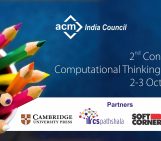Take a random set of adults, Give them a blank sheet of paper. Ask them to draw. ..and chances are that you will get stick figure drawings of a House, smiley or a tree…and a sheepish smile that says, ”Oh, I can never be an artist ! I stopped drawing after I left school”.
Take a random set of Grade 1 or Grade 2 children. Give them a blank sheet of paper. Ask them to draw…and it’s definite that you will get squiggles and scrawls …but which will mean much more than that….it could be the butterfly that flit past in the morning, or the worm that crawled beside them or the bird that tweeted at them to come out and play. …every line on that sheet would make eminent sense to them , and you, if you were to see it through their eyes.
So what is the difference between the two scenarios? The suppression of two innate capabilities of every human in one and the vivid expression of it in the other – Curiosity and Observation.
It has always flummoxed me as to why we as adults can put our “mature” heads together to find so called solutions to BIG problems, but have had to snip it off all creativity and soul? So when we were looking at approaching Computing from another angle through CSPathshala, my premise was that all Computing must stem from being able to see patterns – patterns which may be the in your face kind-like an Odd/Even/Fibonacci series or some that have to be culled out by applying thought and creativity – like seeing similarities in two totally unrelated objects – let’s say a cloud and a swab of cotton.
So for every 21st century child who is expected to become a Problem solver, he/she must be equipped to first notice the problem, find the pattern and then connect the dots in different scenarios. Alongwith that the learner must carry that trait that keeps you on the constant learning curve – curiosity.
To bind these seemingly disconnected processes, and also to encourage elementary students to see that even great things could be simplified, we felt our students must not just learn the tools of lets say a graphic/painting utility like Paint but also have the confidence to recreate masterpieces of famous artists. So that’s how Piet Mondrian came to Computing class.
The artwork was shown, students were asked what was special about it, whether this was used beyond the canvas anywhere and if so where all. Once the students had a grasp of about the artwork, they set about replicating it through both computers and craftwork. The next challenge set for them was to find where else could they see similar patterns. It surprised the teachers when students found Piet Mondrian patterns in places we had never noticed…the school sofa, the design on a teacher’s clothing.
Once done , the question that they came up with was, “Can we make one of our own in similar patterns on the computer?” So at the end of these highly active sessions, the class was well versed in the concept of Primary colours, composition and layout at a basic level, exposed to a renowned artist and also confident that they could themselves create art in his style. Almost as an afterthought, a small byproduct of this activity was that they also learnt to notice patterns beyond the canvas, learnt Paint thoroughly and would turn up eagerly for the next Computing class.
At the end, all I can say through this experimental session, we as a team realised that children can actually grasp a phenomenal amount of knowledge wihen they are NOT taught against their natural way of learning. Try this experiment , and you would be just as surprised as us !
– Susanna Sunil, Vice Principal -IT, Systems & Communication, Global Public School, Kerala


